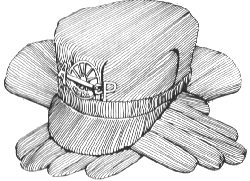
In the Achievement Program there are rules, regulations and requirements. These items are examined and certified by qualified witness who must follow judging procedures; however, judging anything includes personal standards and preferences.
In general, judging is subjective, involving an individual's perception and emotions. Therefore, scoring a model or scene will vary between judges in most cases. Since more than one person is judging, the scores will usually balance out. Many judges will indicate what parts failed. This information can be a valuable education to the modeler. If you fail and no notes are given, be sure to ask the judges for this information. Correcting deficiencies, if possible, should put you over 87.5 points, but there are no guarantees.
Another common situation in Prototype Modeler is the interpretation of the requirements. This has been reduced with recent revisions. If you are confused with any piece of the Prototype Modeler requirements, or any certificate for that matter, then contact your local AP Manager for clarification. In my case, I did that before construction, and it paid off.
First, I discussed the items with my divisional AP Manager. After checking with the regional AP Manager to see if he had any extra information, my divisional AP Manager talked with the national AP Manager, and a few notes between us put me on the right track. My Brooklyn wharf scene was developed and passed the test.
In PM the scenic requirement is specific, but there is some flexibility. Since realism is a major element, modeling needs to be a good miniature representation of the documented pictures and evidence, Realistic interpretation must reflect the feel and flavor of the original scene.
When it came to the background, I used the photographic method (refer to MODEL RAILROADER, October 1988). I photographed the actual area. I selected four pictures and had them made into poster-size prints. I made up a threesided wrap-around scene by combining appropriate pieces, along with some cut-out photos of buildings and cut-out Walthers dock background buildings. I applied some folk art acrylic colors using my fingers to blend the sky and hide the seams. I mounted the background on three pieces of foam core with double-face tape.
A fourth side is removable. This section completes the scene viewed from any side. The fourth side was made with building flats and Details West building cut-outs. These were mounted against a hand-painted skyboard, When I spray painted the base color outside near my hedges with a spray can, they had blue branches for a few months.
Although background scoring now carries only 15 points, mine accounted for 11 under today's scoring, but more importantly it "set the scene." There was no doubt that this was the wharf in Brooklyn, near the Williamsburg Bridge. So don't overlook the backdrop.
Before calling for your "check," here are some suggestions. First, take pictures of your scene, especially slides since you can see more. Use these to compare the modeling to the prototype pictures. Adjust what's needed, especially details and weathering.
Second, judge your work with a critical eye. Also do this with your photos, they will show most of the problems. Then ask someone else to do the same. Correct whatever you can. It was interesting, my score (which didn't count) was the same as one of the judges'-a 95.
Another thing I did to help the judges and highlight my work was to write a precise report on the scenic details for the requirements. Then I made copies so each judge had information which related to the scene as a checklist. I also used several documents, pictures, and evidence for verification. This made the judges' job easier.
Judging is a difficult, yet rewarding experience for most people, This is an opportunity to meet another skilled craftsman, learn something, plus they earn points toward the Volunteer Certificate. Thank goodness we have individuals willing to do this valuable job; and be sure to thank them.